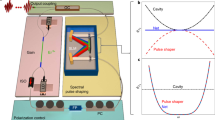The study examines suppression of peak intensity fluctuations in a sequence of fixed-energy femtosecond pulses by so-called cascade second harmonic generation (SHG). In Part II we analyze the propagation of a sequence of subpulses in an optical fiber without self-interaction characterized by cubic nonlinearity and large wavenumber detuning between the principal mode and the second harmonic. The propagation regimes discovered for a sequence of femtosecond pulses ensure suppression of peak intensity fluctuations. The mean peak intensity can be simultaneously increased by chirping the pulses in a particular section and also by adjusting the wavenumber detuning and increasing the quadratic nonlinearity while at the same time reducing to zero the phase of the distribution when the pulses pass to a new part of the nonlinear system.
Similar content being viewed by others
References
Yu. N. Karamzin and A. P. Sukhorukov, Pis'ma v ZhETF, 20, 734–739 (1974).
A. V. Buryak, P. Di Trapani, D. V. Skryabin, and S. Trillo, Physics Reports, 370, No. 2, 63–235 (2002).
S. Ashihara, J. Nishina, T. Shimura et al., JOSA B, 19, 2505–2510 (2002).
N. A. Papadogiannis et al., Phys. Rev. Lett., 90, 133902 (2003).
N. A. Papadogiannis et al., Appl. Phys. B, 73, 687 (2001).
C. Altucci et al., Phys. Rev. A, 61, 021801 (2000).
P. M. Paul et al., Science, 292, 1689 (2001).
D. Charalambidis et al., Physica Scripta (TI), T105, 23–26 (2003).
U. Teubner et al., Phys. Rev. A, A67, 013816 (2003).
A. Hertz et al., Phys. Rev. A, 64, 051801 (2001).
V. V. Steblina, Y. S. Kivshar, M. Lisak, and B. A. Malomed, Optics Communications, 118, 345–352 (1995).
J. Sun, D. Liu, and D. Huang, Optical and Quantum Electronics, 36, 577–587 (2004).
C. R. Menyak, R. Schiek, and L. Torner, JOSA B, 11, No. 12, 2434–2443 (1994).
L. Torner, D. Mihalache, D. Mazilu, E. M. Wright, W. E. Torruellas, and G. I. Stegeman, Optics Communications, 121, 149–155 (1995).
Y. S. Kivshar and D. E. Pelinovsky, Physics Reports, 331, 117–195 (2000).
I. Towers and B. A. Malomed, JOSA B, 19, No. 3, 537–543 (2002).
B. A. Malomed, D. Mihalache, F. Wise, and L. Torner, J. Opt. B: Quantum and Semiclass. Opt., 7, R53–R57 (2005).
F. Wise and P. Di Trapani, Opt. Photon. News, 13, No. 12, 29–34 (2002).
Y.-F. Chen, K. Beckwitt, and F. Wise, Phys. Rev. E, E70, No. 4, 046610 (2004).
X. Lui, K. Beckwitt, and F. Wise, Phys. Rev. E, 61, No. 5, R4722–R4725 (2000).
X. Lui, K. Beckwitt, and F. Wise, Phys. Rev. E, 62, No. 1, 1328–1340 (2000).
Yu. S. Kivshar and G. P. Agrawal, Optical Solitons: From Fibers to Photonic Crystals [Russian translation], Fizmatlit, Moscow (2005).
N. N. Akhmediev and A. Ankevich, Solitons: Nonlinear Pulses and Beams [in Russian], Fizmatlit, Moscow (2003).
N. N. Rozanov, S. V. Fedorov, and A. N. Shatsev, Optics and Spectroscopy, 102, No. 1, 83–85 (2007).
T. M. Lysak and V. A. Trofimov, “On the possibility of a soliton-like regime of two-wave femtosecond pulse propagation in an optical fiber under SHG conditions,” Optika i Spektroskopiya, 94, No. 4, 808–814 (2003).
T. M. Lysak and V. A. Trofimov, “On the possibility of generation of a sequence of attosecond pulses with SHG of high-intensity femtosecond pulses,” Pis'ma v ZhTF, 30, No. 13, 83–88 (2004).
V. A. Trofimov and T. M. Lysak, “Soliton-like regime of femtosecond laser pulse propagation in bulk media under the conditions of SHG,” in: Proc. Int. Conf. NAA'4, Lect. Notes Math., Vol. 3401, Springer (2005), pp. 542–549.
Author information
Authors and Affiliations
Corresponding author
Additional information
For Part I, See Prikladnaya Matematika i Informatika, No. 27, pp. 5–24, 2007; English Translation: Computational Mathematics and Modeling, Vol. 19, No. 4, pp. 333–342, 2008.
Translated from Prikladnaya Matematika i Informatika, No. 28, pp. 5–36, 2008.
Rights and permissions
About this article
Cite this article
Lysak, T.M., Trofimov, V.A. Achieving high-efficiency second harmonic generation in a sequence of laser pulses with random peak intensity. Part II. Suppression of intensity fluctuations in a quadratic-nonlinearity medium. Comput Math Model 20, 1–25 (2009). https://doi.org/10.1007/s10598-009-9015-4
Published:
Issue Date:
DOI: https://doi.org/10.1007/s10598-009-9015-4




